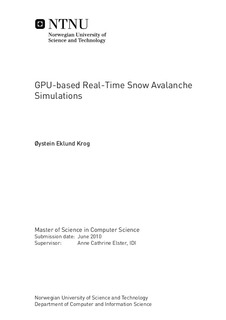| dc.description.abstract | Snow is a physical phenomenon that is hard to simulate due to the wide range of behaviors that can be found. Snow avalanches are of interest due to their complex physical properties and because they can have a very high cost, both in terms of economic impact and lives lost. In this thesis, we investigate the possibility of using fluid dynamics to model snow avalanches at real-time speeds. Real-time simulations allow for interactivity which again may accelerate the speed of development processes. It also allows for the simulations to be used as an interactive educational tool.Although modern GPUs (Graphics Processing Units) are primarily designed to accelerate graphics calculations in computer games, their computational power can now also be harnessed by several other applications. This thesis builds on our previous work on a simple Smoothing Particle Hydrodynamics (SPH) fluid dynamics model accelerated by GPUs. We extend this work by developing a more complex SPH model and integrate these two models in our novel framework for GPU simulations. The simple SPH model is suitable for interactive simulations of low-viscosity Newtonian fluids, whereas our more complex SPH model includes support for Non-Newtonian fluids through the use of rheological models. By using a rheological model that describes the Non-Newtonian flow characteristics of snow avalanches, we can reproduce the flowing behavior of dense flowing snow avalanches at interactive speeds. Our work shows that using the GPU can lead to very large performance improvements that make it possible to do real-time simulations which previously required costly specialized hardware or took minutes or hours to run. Using our highly optimized framework, we demonstrate a large improvement in performance for the simple model, and achieve generally very high performance for both implementations compared to other state-of-the-art implementations. Our recent results on the new NVIDIA Geforce GTX 470 Fermi-based card, achieves 215.4 IPS (iterations per seconds) for 64K particles using our simple model, and 122.2 IPS and 64.9IPS for 128K and 256K particles, respectively. For the complex model, 69.6 IPS at 64K particles, 37.4 IPS at 128K particles and 19.1 IPS at 256K particles were achieved. Real-time simulations enabling interactivity for the simple model is achieved for up to 256K particles, and up to 32/64K particles for the complex model.Many other features, such as additional snow and fluid effects, could extend this work. A list of this and other possible avenues for future work is also included. | nb_NO |

